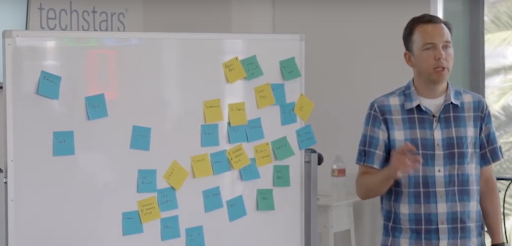So one of your student teams has made the first few sales of their new business. Terrific! It is time to celebrate. Once the party is over, however, get ready for more work: Now you will likely need to help them to identify and track their KPIs (key performance indicators). The content and exercises in this learning module require your students come to a thorough understanding of their individual customer’s buyer journey. Ultimately, having strong KPIs will help them make decisions, pivot when necessary, and ultimately grow their business. So let’s get started!
Lots of people talk about KPIs. And as a result, students may roll their eyes when you ask about them. If this is the case, it may be helpful to emphasize the four reasons KPIs are so important:
- They create a shared understanding of progress and potential inside a company and team and with investors (and, importantly, with potential investors).
- They help explain business concepts, customer needs, technologies, etc. to audiences that have not studied a subject matter (and therefore may not understand the business).
- They provide a structure for strategic thinking and enable your students to make better decisions.
- They validate learning by enabling comparison of expected outcomes (a hypothesis) with actual outcomes.
Part 1: Understand KPIs (Module videos 1, 2, and 3)
Before students can figure out which metrics they should be tracking, it may be useful to review some vocabulary with them:
- Vanity Metrics vs. Actionable Metrics. Vanity metrics are used for bragging: Customers, downloads, subscribers. Actionable metrics are often predictive and help you adjust (or repeat) to make progress in the business.
- Stock Metrics vs. Flow Metrics. Stock metrics are cumulative (never go down). Flow metrics are those you look at over time and today/this week/this month’s quantity can be compared to that period in the past to measure success.
- Qualitative vs. Quantitative Metrics. Qualitative metrics are the stories and quantitative metrics are the numbers. Both are important - but for different reasons.
- Leading vs. Lagging Metrics. The difference here is between future outlook and past performance. (Good news for startups is that larger companies often overly focus on lagging metrics and are unable to quickly adjust course and take advantage of opportunities.)
- Generic, Specific, and Behavioral. Examples of these (in order) are available cash, recurring revenue, and hours saved per workflow. Having all three of these kinds help entrepreneurs understand the nuance of their business, but the behavioral metrics are most important for identifying opportunities to achieve growth.
- Correlation and Causation. Though metrics shifting at or near the same time or to the same degree may seem to have a causation relationship, it is likely that many are merely correlated. Understanding how directly one action leads to a change in performance is key.
STUDENT ACTIVITY: The worksheet associated with the module is a good tool to assign once students have become familiar with these terms. Alternatively, you may ask your students to provide a list 3-5 KPIs for their business and then discuss with them which of these categories they each fit into.
It is also important at this point, to discuss with students the difference between Management, Investor, and Accounting KPIs:
- Accounting KPIs are common and often the easiest to identify - they also tend to be the most lagging indicators. Ex: Cash balance, sales, expenses.
- Investor KPIs are important and student founders should be prepared to have answers to and report on things like burn rate, customers/users, monthly recurring revenue.
- Management KPIs the most important zone - strategically speaking - for students to focus on. These are the metrics that are most leading and most behavioral. They are also completely unique to an individual business.

Part 2: Identify KPIs (Module video 7)
STUDENT ACTIVITY: After teaching them the above KPI terminology, it is time to identify the critical KPIs for their business. (Don’t worry - these can always be changed if they or you determine what was initially selected is no longer what they need to be tracking.) To begin with, view the 7th video from this module together.
It provides an example using Jack’s Stands and Marketplace.
Next up, time to pull out three colors of sticky notes!

Step 1: Start with where the money comes in the door (the sale) or if a student’s business is pre-revenue, where does he/she/they expect this to occur. (Post-it color #1)
Step 2: What is the customer experience immediately preceding the sale/transaction? (Not what the student or business does, what is the customer doing just beforehand.) And then ask again: What is the customer experiencing immediately preceding that? What are all activities and feelings a customer is having before they even know the student’s business exists? What causes the problem they need to solve? What is the referral experience - how they refer them to a friend/the next customer? (Post-it color #2)
Step 3: Next up, time to consider what are the customer’s experiences immediately following the sale/transaction once the product or service is in their hand? (Post-it color #2)
Step 4: Once you and the student(s) have all of this mapped out. Identify the measurable actions in this journey - these are KPIs. (Post-it color #3)
Step 5: Now prioritize these possible KPIs. What are the spots in this map where the customer is getting the most value and where the experience is most critical? Which KPIs are leading and behavioral (vs. lagging and generic)?
Students should leave this meeting having selected 2-3 of these measurable moments. These are their first KPIs. Determine when they’ll have time to make some progress and schedule a follow-up meeting. At that time, ask the students to report back on those agreed-to metrics and discuss whether they need to be adjusted.
Part 3: KPI Monitoring (Module video 4)
Once a business is truly moving, Zach recommends weekly meetings. These may occur less frequently for students and their teams as their businesses are just getting started and they are only working on them part-time. (Certainly, campus directors do not need to be in all of these team meetings!) Participating in monthly or quarterly KPI review meetings should be sufficient to keep students on track. A recommended agenda for these meeting is:
- Good News - Business (and personal) accomplishments.
- Review Business Goals - Both since the previous meeting and longer term.
- Review KPI Progress - Why KPIs exceeded, met, or fell short of expectations?
- Clear the Issues - How can improvements be made by the next meeting?
Note: Videos 5 & 6 are recordings of some KPI Q&A (selecting and getting KPI buy-in and connecting KPIs to the entrepreneur’s “gut instinct”).
 Further Campus Director Reading: Think With Google has developed another excellent KPIs framework “See-Think-Do-Care”. For more information check out this article.
Further Campus Director Reading: Think With Google has developed another excellent KPIs framework “See-Think-Do-Care”. For more information check out this article.






